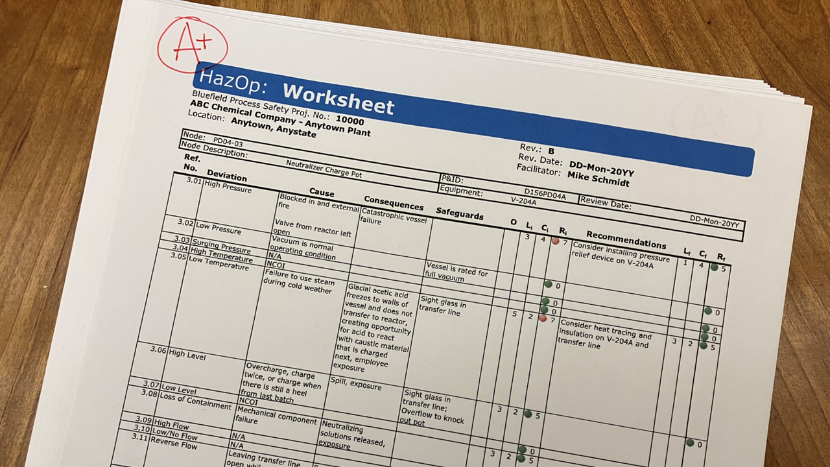“Perfection is not attainable, but if we chase perfection, we can catch excellence.” — Vince Lombardi
I don’t believe that I have ever facilitated a perfect PHA. The question is, how would I recognize it if it was perfect? And would others agree?
What exactly is a perfect PHA?
A PHA Identifies Hazards
The primary purpose of a process hazard analysis (PHA) is to identify the hazards of a process. Process hazards are hazards that could lead to fires, explosions, or toxic releases. They don’t normally address slips, trips, and falls, or contact with objects. A perfect PHA is a PHA that identifies every process hazard in a process. If a PHA a misses a hazard, then it’s not perfect.
Unfortunately, PHA teams don’t know that they have missed hazards when they simply don’t recognize them. It’s a classic case of “you don’t know what you don’t know.” Every PHA misses some hazards, so by this definition, no PHA can be perfect.
The Perfect PHA Team
The PHA doesn’t find hazards—the PHA team does. OSHA’s minimum requirements for a PHA team is that it consists of at least two people and includes “expertise in engineering and process operations” and “at least one employee who has experience and knowledge specific to the process being evaluated.” So, someone who knows how things are supposed to work and someone who knows how things really work. OSHA also requires that there be a PHA facilitator who knows what they are doing.
Three really knowledgeable people who all respect each other would be the perfect team. They would know what needs to be known, would trust each other, and at the end of every PHA session, would feel like they had made a meaningful contribution to the PHA.
OSHA requirements do not list a maximum allowed number of team members; most PHA teams have more than three members. Sometimes it is because no single person has all the required expertise. Sometimes it is because more than three departments want a representative on the PHA team to look out for their department’s interests. Any PHA review session that concludes with one or more members not having contributed is not a perfect PHA
The Perfect Risk Assessment
When the PHA team identifies a hazard, they have identified a feature of the process that has the potential to result in an incident when things don’t go as intended—when someone doesn’t do as intended or when something doesn’t work as intended. The team then has the responsibility of determining how bad things will be when an incident occurs. In other words, the consequence severity. But consequence doesn’t equal risk. The team must also determine the likelihood of the incident.
In a perfect risk assessment, the PHA team correctly estimates the consequence severity of a potential incident. They don’t overstate it, and they don’t shrug it off. Not all hazards result in a fatality, regardless of our wildest imaginings, but some hazards do have the potential to be catastrophic. The fact that nothing bad has happened in the last 16 years is not proof that nothing bad can happen.
That’s not enough, though. The PHA team must also correctly estimate the likelihood of the incident resulting in the anticipated consequence severity. The fetish about “worst case scenarios” can be managed, so long as the likelihood of that worst case scenario is correctly estimated.
The Perfect Recommendation
Project managers often sit on PHA teams with the sole purpose of resisting any changes to their project that will increase its cost. From their perspective, the perfect PHA is one with no recommendations. They’re wrong.
The only way a perfect PHA can result in no recommendations is if the process itself is perfect. But since the only perfect project is the one that is never built, there will be recommendations.
So, what makes for a perfect recommendation? First, it actually addresses the hazard or resulting incident when it works as designed. Second, it is practical and creates no new hazards. And third, it costs no more than necessary to achieve the necessary risk reduction. Perhaps it even reduces the cost of the project and process.
A Perfect PHA
A perfect PHA doesn’t depend on having a perfect process to start with. Instead, it depends on four things:
PHA team: The team is no bigger than necessary to fulfill all the requirements of the OSHA PSM regulations and more importantly, captures all the experience and expertise necessary to analyze the process.
Hazard identification: Every hazard in the process is identified, and features that are not hazards are not identified as hazards.
Risk assessment: The consequence severity of potential incidents resulting from hazards are correctly judged, and the likelihood of their occurrence, given the anticipated severity, the initiating cause, and the probability of safeguards providing the intended protection, is correctly estimated.
Recommendations: The PHA only makes recommendations that eliminate hazards or reduce risk to a tolerable level, while being practical and costing no more than necessary. There is no virtue in spending resources that do not need to be spent.
Oh, and there is one more aspect of a perfect PHA. It takes as long a necessary to do the job, and not a minute longer. The members of the PHA team all have day jobs they have to get back to.
Continuously Improving Our PHA Skills
To paraphrase Vince Lombardi, a perfect PHA is not possible, but if we don’t try, we cannot even achieve an excellent PHA. We cannot strive for perfection if we don’t know what it looks like. For the PHA facilitators and PHA team members who are working at continuously improving their PHA skills, these four facets—teams, hazard identification, risk assessment, and recommendations—are areas to focus on.

Leave A Comment